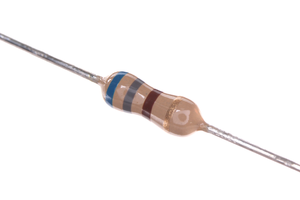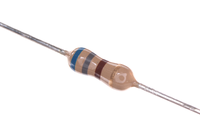Difference between revisions of "Resistor"
| Line 10: | Line 10: | ||
: The [[Electrical Resistance|resistance]] of a [[resistor]] can be found by attaching an [[ammeter]] in [[Series Circuit|series]] with the [[resistor]] and a [[voltmeter]] in [[Parallel Circuit|parallel]] with the [[resistor]]. | : The [[Electrical Resistance|resistance]] of a [[resistor]] can be found by attaching an [[ammeter]] in [[Series Circuit|series]] with the [[resistor]] and a [[voltmeter]] in [[Parallel Circuit|parallel]] with the [[resistor]]. | ||
: All [[electrical component|component]]s in a [[circuit]] act as [[resistor]]s, including [[wire]]s. The longer a [[wire]] the more [[Electrical Resistance|resistance]] it will have to a [[Electrical Current|current]]. | : All [[electrical component|component]]s in a [[circuit]] act as [[resistor]]s, including [[wire]]s. The longer a [[wire]] the more [[Electrical Resistance|resistance]] it will have to a [[Electrical Current|current]]. | ||
| + | |||
| + | {| class="wikitable" | ||
| + | |- | ||
| + | |[[File:Resistor.png|center|200px]] | ||
| + | |[[File:ResistorSymbol.png|center|200px]] | ||
| + | |- | ||
| + | | style="height:20px; width:200px; text-align:center;" |A [[resistor]]. | ||
| + | | style="height:20px; width:200px; text-align:center;" |The symbol for a [[resistor]]. | ||
| + | |} | ||
| + | |||
| + | ==Key Stage 4== | ||
| + | ===Meaning=== | ||
| + | [[File:ResistorSymbol.png|right|300px|thumb|The symbol for a [[resistor]].]] | ||
| + | A [[resistor]] is a [[Electrical Component|component]] in an [[circuit|electrical circuit]] which makes it difficult to [[electricity]] to pass through it. | ||
| + | |||
| + | ===About Resistors=== | ||
| + | : A [[resistor]] is a [[Electrical Component|component]] designed to have a particular [[Electrical Resistance|resistance]]. | ||
| + | : [[Resistor]]s are added to [[circuit]]s to control the [[Electrical Current|current]] which will pass through for a certain [[Potential Difference|potential difference]]. | ||
| + | : The greater the [[Electrical Resistance|resistance]] of a [[resistor]] the smaller the [[Electrical Current|current]] will be. | ||
| + | : The [[Electrical Resistance|resistance]] of a [[resistor]] can be found by attaching an [[ammeter]] in [[Series Circuit|series]] with the [[resistor]] and a [[voltmeter]] in [[Parallel Circuit|parallel]] with the [[resistor]]. | ||
| + | : All [[electrical component|component]]s in a [[circuit]] act as [[resistor]]s, including [[wire]]s. The longer a [[wire]] the more [[Electrical Resistance|resistance]] it will have to a [[Electrical Current|current]]. | ||
| + | |||
| + | ===Resistors in Series=== | ||
| + | : Adding [[resistor]]s in [[Series Circuit|series]] increases the [[Electrical Resistance|resistance]] in the [[circuit]]. | ||
| + | |||
| + | ===Resistors in Parallel=== | ||
| + | ''NB: You only need to know what happens with identical [[resistors]] in [[Parallel Circuit|parallel]]. | ||
Revision as of 13:29, 27 February 2019
Contents
Key Stage 3
Meaning

A picture of a resistor.
A resistor is a component in an electrical circuit which makes it difficult to electricity to pass through it.
About Resistors
- A resistor is a component designed to have a particular resistance.
- Resistors are added to circuits to control the current which will pass through for a certain potential difference.
- The greater the resistance of a resistor the smaller the current will be.
- The resistance of a resistor can be found by attaching an ammeter in series with the resistor and a voltmeter in parallel with the resistor.
- All components in a circuit act as resistors, including wires. The longer a wire the more resistance it will have to a current.
| A resistor. | The symbol for a resistor. |
Key Stage 4
Meaning

The symbol for a resistor.
A resistor is a component in an electrical circuit which makes it difficult to electricity to pass through it.
About Resistors
- A resistor is a component designed to have a particular resistance.
- Resistors are added to circuits to control the current which will pass through for a certain potential difference.
- The greater the resistance of a resistor the smaller the current will be.
- The resistance of a resistor can be found by attaching an ammeter in series with the resistor and a voltmeter in parallel with the resistor.
- All components in a circuit act as resistors, including wires. The longer a wire the more resistance it will have to a current.
Resistors in Series
- Adding resistors in series increases the resistance in the circuit.
Resistors in Parallel
NB: You only need to know what happens with identical resistors in parallel.

